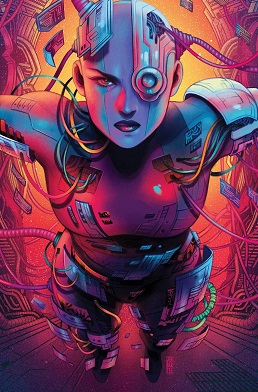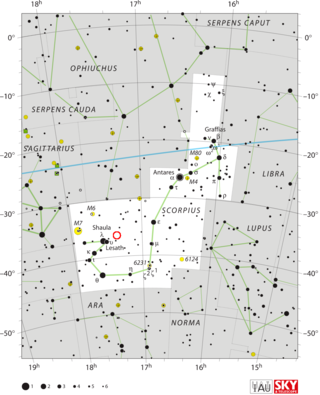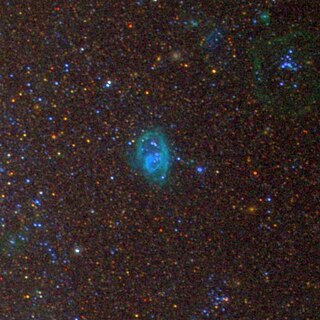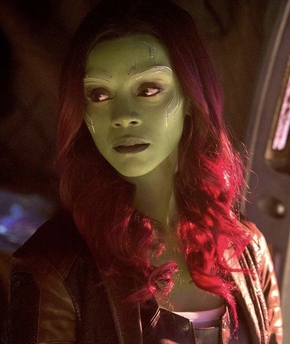
The Crab Nebula is a supernova remnant and pulsar wind nebula in the constellation of Taurus. The common name comes from a drawing that somewhat resembled a crab with arms produced by William Parsons, 3rd Earl of Rosse, in 1842 or 1843 using a 36-inch (91 cm) telescope. The nebula was discovered by English astronomer John Bevis in 1731. It corresponds with a bright supernova recorded by Chinese astronomers in 1054 as a guest star. The nebula was the first astronomical object identified that corresponds with a historically-observed supernova explosion.

The Orion Nebula is a diffuse nebula situated in the Milky Way, being south of Orion's Belt in the constellation of Orion, and is known as the middle "star" in the "sword" of Orion. It is one of the brightest nebulae and is visible to the naked eye in the night sky with apparent magnitude 4.0. It is 1,344 ± 20 light-years (412.1 ± 6.1 pc) away and is the closest region of massive star formation to Earth. The M42 nebula is estimated to be 24 light-years across. It has a mass of about 2,000 times that of the Sun. Older texts frequently refer to the Orion Nebula as the Great Nebula in Orion or the Great Orion Nebula.

The Boomerang Nebula is a protoplanetary nebula located 5,000 light-years away from Earth in the constellation Centaurus. It is also known as the Bow Tie Nebula and catalogued as LEDA 3074547. The nebula's temperature is measured at 1 K making it the coolest natural place currently known in the Universe.
76 (seventy-six) is the natural number following 75 and preceding 77.
The Nebula Award for Best Short Story is a literary award assigned each year by Science Fiction and Fantasy Writers Association (SFWA) for science fiction or fantasy short stories. A work of fiction is defined by the organization as a short story if it is less than 7,500 words; awards are also given out for longer works in the categories of novel, novella, and novelette. To be eligible for Nebula Award consideration a short story must be published in English in the United States. Works published in English elsewhere in the world are also eligible provided they are released on either a website or in an electronic edition. The Nebula Award for Best Short Story has been awarded annually since 1966. The award has been described as one of "the most important of the American science fiction awards" and "the science-fiction and fantasy equivalent" of the Emmy Awards.
The Damon Knight Memorial Grand Master Award is a lifetime honor presented annually by the Science Fiction and Fantasy Writers Association (SFWA) to no more than one living writer of fantasy or science fiction. It was first awarded in 1975, to Robert Heinlein, and was renamed in 2002 for Damon Knight, the Association's founder, who had died that year.

Astronomy Picture of the Day (APOD) is a website provided by NASA and Michigan Technological University (MTU). According to the website, "Each day a different image or photograph of our universe is featured, along with a brief explanation written by a professional astronomer." The photograph does not necessarily correspond to a celestial event on the exact day that it is displayed, and images are sometimes repeated. However, the pictures and descriptions often relate to current events in astronomy and space exploration. The text has several hyperlinks to more pictures and websites for more information. The images are either visible spectrum photographs, images taken at non-visible wavelengths and displayed in false color, video footage, animations, artist's conceptions, or micrographs that relate to space or cosmology. Past images are stored in the APOD Archive, with the first image appearing on June 16, 1995. This initiative has received support from NASA, the National Science Foundation, and MTU. The images are sometimes authored by people or organizations outside NASA, and therefore APOD images are often copyrighted, unlike many other NASA image galleries.

The Saturn Nebula is a planetary nebula in the constellation Aquarius. It appears as a greenish-yellowish hue in a small amateur telescope. It was discovered by William Herschel on September 7, 1782, using a telescope of his own design in the garden at his home in Datchet, England, and was one of his earliest discoveries in his sky survey. The nebula was originally a low-mass star that ejected its layers into space, forming the nebula. The central star is now a bright white dwarf star of apparent magnitude 11.5. The Saturn Nebula gets its name from its superficial resemblance to the planet Saturn with its rings nearly edge-on to the observer. It was so named by Lord Rosse in the 1840s, when telescopes had improved to the point that its Saturn-like shape could be discerned. William Henry Smyth said that the Saturn Nebula was one of Struve's nine "Rare Celestial Objects".

Sh2-279 is an HII region and bright nebulae that includes a reflection nebula located in the constellation Orion. It is the northernmost part of the asterism known as Orion's Sword, lying 0.6° north of the Orion Nebula. The reflection nebula embedded in Sh2-279 is popularly known as the Running Man Nebula.

Nebula is a fictional character appearing in American comic books published by Marvel Comics. Created by Roger Stern and John Buscema, the character first appeared in The Avengers #257. Originally depicted as a supervillain, Nebula was later depicted as an antihero and member of the Guardians of the Galaxy.

NGC 6334, colloquially known as the Cat's Paw Nebula, Bear Claw Nebula, or Gum 64, is an emission nebula and star-forming region located in the constellation Scorpius. NGC 6334 was discovered by astronomer John Herschel in 1837, who observed it from the Cape of Good Hope in South Africa. The nebula is located in the Carina–Sagittarius Arm of the Milky Way, at a distance of approximately 5.5 kilolight-years from the Sun.

Amal El-Mohtar is a Canadian poet and writer of speculative fiction. She has published short fiction, poetry, essays and reviews, and has edited the fantastic poetry quarterly magazine Goblin Fruit since 2006.
Alyssa Wong is an American writer of speculative fiction, comics, poetry, and games. They're a recipient of the Nebula Award, World Fantasy Award, and Locus Award.
Sarah Pinsker is an American science fiction and fantasy author. She is a nine-time finalist for the Nebula Award, and her debut novel A Song for a New Day won the 2019 Nebula for Best Novel while her story Our Lady of the Open Road won 2016 award for Best Novelette. Her novelette "Two Truths and a Lie" received both the Nebula Award and the Hugo Award. Her fiction has also won the Philip K. Dick Award, the Theodore Sturgeon Memorial Award and been a finalist for the Hugo, World Fantasy, and Tiptree Awards.

NGC 588 is a prominent, giant H II ionized diffuse nebula located in the outskirts of the galaxy Messier 33's spiral arms, within the Triangulum constellation. The nebula has two Wolf-Rayet stars, NGC 588-UIT 008 and NGC 588-MC3 and a fairly large population of main sequence stars of 2 to 20 solar masses. The more massive stars in the nebula have a mass of around 40 solar masses. NGC 588 is 4.2 million years old and has a mass of 2300 solar masses.

NGC 2032 is an emission nebula in the Dorado constellation and near the supershell LMC-4 and it consists of NGC 2029, NGC 2035 and NGC 2040. It was first discovered by James Dunlop on 27 September 1826, and John Herschel rerecorded it on 2 November 1834. NGC 2032 is located in the Large Magellanic Cloud.

NGC 2029 is an emission nebula in the Dorado constellation and is part of the Large Magellanic Cloud. It is part of a complex of nebulae and stars, including NGC 2032, NGC 2035 and NGC 2040. It was discovered by James Dunlop on the 27 September 1826. Its apparent magnitude is 12.29, and its size is 2.25 arc minutes.
Dexter Gabriel, better known by his pen name Phenderson Djèlí Clark, is an American speculative fiction writer and historian, who is an assistant professor in the department of history at the University of Connecticut. He uses a pen name to differentiate his literary work from his academic work, and has also published under the name A. Phenderson Clark. His pen name "Djèlí", makes reference to the griots – traditional Western African storytellers, historians and poets.

Gamora is a fictional character portrayed primarily by Zoe Saldaña in the Marvel Cinematic Universe (MCU) media franchise, based on the Marvel Comics character of the same name. Gamora is depicted as a member of the Guardians of the Galaxy, having escaped her previous life as an assassin after she was forcibly adopted by Thanos after he murdered half of her people, including her mother. For the next twenty years, she served Thanos as a cybernetically enhanced warrior until betraying him to join the Guardians. Over time she becomes romantically involved with Peter Quill, and develops a positive relationship with her adopted sister Nebula despite their rivalrous upbringing. She is eventually killed by Thanos when he sacrifices her to obtain the Soul Stone.

Nebula is a fictional character in the Marvel Cinematic Universe (MCU) media franchise, portrayed by Karen Gillan, based on the Marvel Comics character of the same name. She is depicted as a blue-skinned alien warrior who is both the adoptive daughter of Thanos, who killed her blood family before raising her, and the adoptive sister of Gamora, with whom she grew to share a bitter rivalry. Although she is first introduced as the secondary antagonist of Guardians of the Galaxy (2014), subsequent films see her develop into an antihero and eventually a protagonist, who joins her sister as part of the Guardians of the Galaxy and becomes a member of the Avengers and then officially of the Guardians of the Galaxy. Aspects of this interpretation were later integrated into the comics version of the character.














